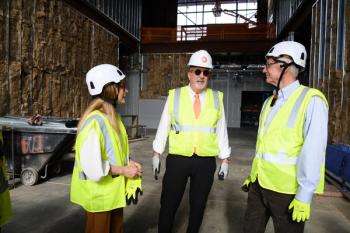
Roadside service for your veterinary practice
Look to associate veterinarian compensation and location for the reasons your practice has a flat (revenue)
In the simplest sense, I've spent the past 25 years of my career as roadside service for Dog and Cat Repair Centers throughout America. And I see a similarity between the economics of the auto industry and veterinary medicine.
In the auto world, superior manufacturing processes have made tire blowouts rare events, but flat tires are becoming more common as road maintenance falls in the wake of municipal budget constraints. In veterinary medicine, practice bankruptcies—unheard of until 2008—are sharply rising while flat veterinary production is rampant. The fault is not hard to guess at: a profound lack of preventive maintenance. Few would buy a Ferrari and put used retreads on before hitting the road, but so many have put Taj Mahal veterinary hospitals in locations incapable of supporting them when the going gets tough. The moral is: Practice owners must never neglect market share. Building into a saturated demographic is usually fatal.
Our innovation ends with medicine
We veterinarians are among the most stubborn of professionals. Sometimes we think we're CPAs and management gurus, too, and make decisions with reckless abandon. Of course, we also think we're experts in interior design, electrical connections, carpentry, roofing, and plumbing. Why not, we take animals apart and fix them—what's so different?
But while we are incredibly innovative in our practice of medicine, we tend to follow the beaten path with regard to economic management issues. A real practice management guru, Bob Levoy, once wrote, "What was good enough, ain't good enough anymore." And in the words of former president Clinton, "The deepest wounds are self inflicted."
The status quo doesn't work. If you're not growing your practice, you're killing it. If your gross revenue is flat compared to last year, you're losing money. Many have cut overhead to the bone, letting that savings prop up their take-home pay. Inflation, though, will continue to spin off a whole new crop of practice failures. Don't fall into that trap!
One too many associates
A proper workload for a veterinarian is 15 to 18 outpatients per day per veterinarian. Do the math—that's 100 transactions a week, 5,000 a year. If you have three veterinarians and only 10,000 transactions, you have an unhealthy bottom line. Just because you have more associates in your practice doesn't mean you have more clients.
If you have three doctors with just 30 outpatients per day, you have one associate too many. Other business owners don't seem to mind laying off a single person to solve their revenue problems. We veterinarians, though, seem to adopt associates for life, irrespective of annual contracts. Cutting back on hours worked seldom works well. My most frequent consulting involves how to compensate associates when there's not enough business to pay them.
How you pay is a problem
Percentage compensation helps, but some practice owners make the mistake of using a minimum base, predicated on 20 percent to 30 percent more transactions and the extra dollars available. So a 22 percent compensation rate with a $108,000 minimum still means paying out $9,000 a month when the 22 percent alone would have produced $79,000, or $6,600 a month. The extra $2,400 that month comes right out of the bottom line. Minimum bases are for the first year or two only, as a new hire gets on his or her feet.
The ranks of associates looking for relief work are swelling as are the number of new graduates unable to find positions. Of course, this is most true in the northern United States. Down south, in places like Texas and Louisiana, population is soaring. Some practices experience 10 percent to 15 percent growth there, while some northern states are shrinking in population daily.
That brings me to the crucial factor: location, location, location.
Plant your seed in the right soil
The most common question I get from veterinarians is, "Can I move my practice somewhere close, keep some of my clients, and bring in more dollars?" Two out of three times, a move of five or so miles can bring a whole new level of success without dislocating home and family.
Where are you now? Sometimes a town with three hospitals can easily sustain a fourth, fifth, or sixth clinic. In other cases, the town without a veterinarian lacks one for a reason. Not enough population! Not enough income! Not enough discretionary income! Not enough per capita pet spending! Simply not enough!
You may be surprised to learn the worst place to open is millionaires' row. Clients with extremely high incomes don't always pay. Dealing with chauffeurs and personal secretaries gets old fast. Wealthy people are often wealthy because they hold onto every dime. I think your best clients are blue-collar, with family incomes of $60,000 to $90,000. Yes, 54 percent of your clients earn more than you do. Live with it!
To find out whether your local area and its neighborhoods are primed for growth, call your local Chamber of Commerce. What does the 2010 estimate say about your neighborhood's five-year projected growth rate? Greater than 5 percent is good. Less than 5 percent means it's time to make some real changes.
Unfortunately, selling a practice in an area with low or shrinking population and income is a herculean challenge. The choice is a bad one: Relocate to a site at a considerable cost or remain where you are with little or no net profit and unable to sell or retire. I hope you never have to make this choice. Practices tend to be successful at five years—or doomed to fail. Almost every bankrupt practice owner realizes too late that he or she stayed too long.
Prevention is key
I guess the big lesson here is: Prevention is the first key to success. No bank or grocery store opens without demographic analysis. Are there 6,000 or more people per veterinarian? Are family incomes high enough to support your level of quality medicine? What is the per capita spending on pets? Is the area's population growing or shrinking? Look before you leap, young associates.
Dr. Snyder, a well-known consultant, publishes Veterinary Productivity, a newsletter for practice productivity. He can be reached at 112 Harmon Cove Towers Secaucus, NJ 07094; (800) 292-7995;
Newsletter
From exam room tips to practice management insights, get trusted veterinary news delivered straight to your inbox—subscribe to dvm360.




